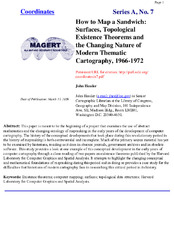| dc.creator | Hessler, John | |
| dc.date.accessioned | 2012-05-05T20:51:49Z | |
| dc.date.available | 2012-05-05T20:51:49Z | |
| dc.date.issued | 2009-03-15 | |
| dc.identifier.issn | 1553-3247 | |
| dc.identifier.uri | https://hdl.handle.net/1969.1/129188 | |
| dc.description.abstract | This paper is meant to be the beginning of a project that examines the use of abstract mathematics and the changing ontology of mapmaking in the early years of the development of computer cartography. The history of the conceptual developments that took place during this revolutionary period in the history of mapmaking is both controversial and incomplete. Much of the primary source material has yet to be examined by historians, residing as it does in obscure journals, government archives and in obsolete software. This study provides a look at one example of this conceptual development in the early years of computer cartography through a close reading of two papers on existence theorems published by the Harvard Laboratory for Computer Graphics and Spatial Analysis. It attempts to highlight the changing conceptual and mathematical foundations of mapmaking during this period and in doing so provides a case study for the difficulties that historians of modern cartography face in researching this critical period in its history. | en |
| dc.language.iso | en_US | |
| dc.publisher | ALA Map and Geography Round Table | |
| dc.relation.ispartofseries | Coordinates ; Series A;7 | |
| dc.subject | existence theorems | en |
| dc.subject | computer mapping | en |
| dc.subject | surfaces | en |
| dc.subject | topological data structures | en |
| dc.subject | Harvard Laboratory for Computer Graphics and Spatial Analysis | en |
| dc.title | How to Map a Sandwich: Surfaces, Topological Existence Theorems and the Changing Nature of Modern Thematic Cartography, 1966-1972 | en |
| dc.type | Article | en |
| dc.rights.requestable | false | en |


